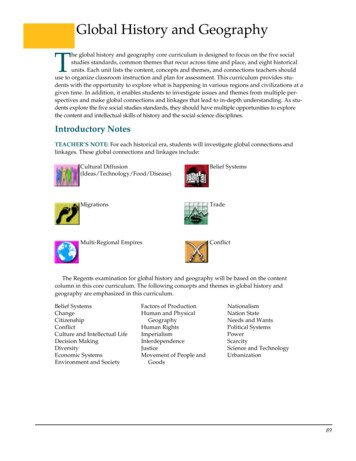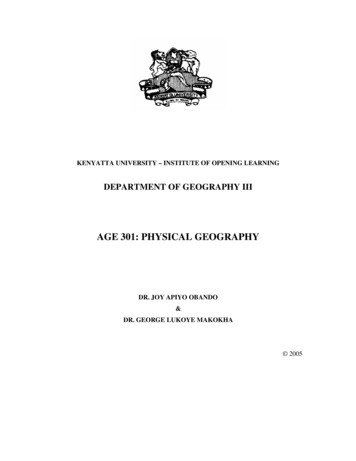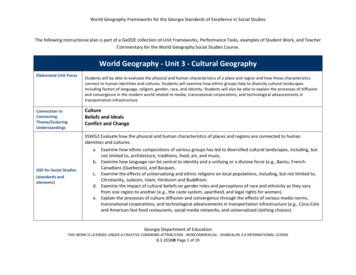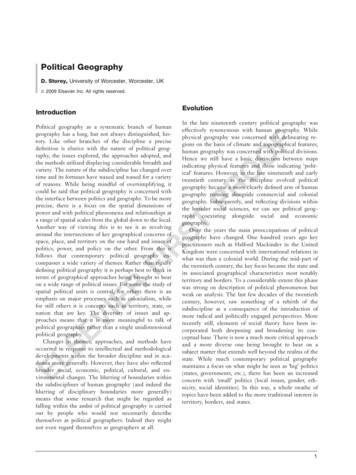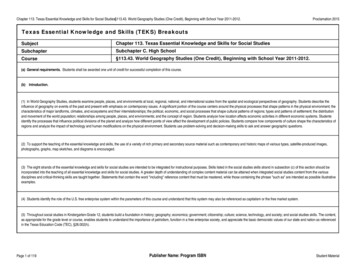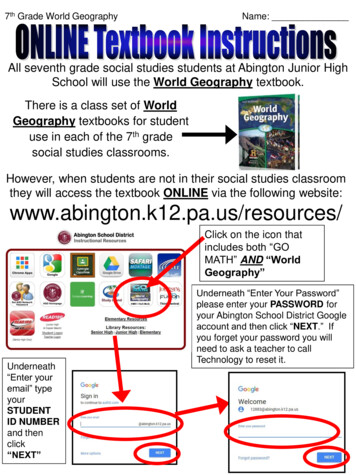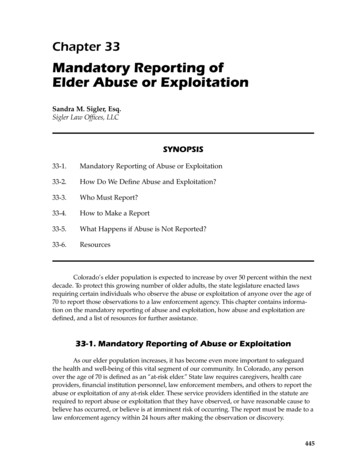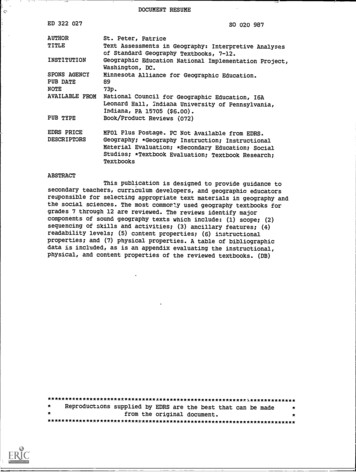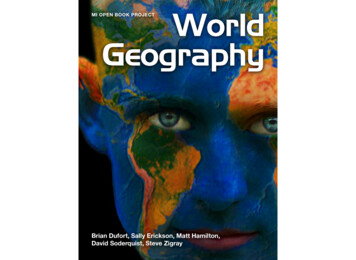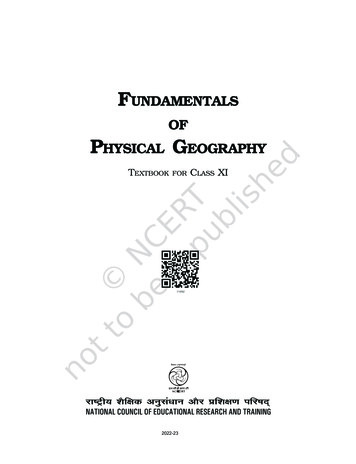
Transcription
FUNDAMENTALSOFPHYSICAL GEOGRAPHYTEXTBOOKFOR2022-23CLASS XI
11092 – F UNDAMENTALSOFP HYSICAL G EOGRAPHYISBN 81-7450-518-0Textbook for Class XI First EditionMarch 2006 Phalguna 1927ReprintedOctober 2006 Kartika 1928November 2007 Kartika 1929December 2008 Pausa 1930January 2010 Pausa 1931January 2011 Magha 1932March 2012 Phalguna 1933January 2013 Magha 1934November 2013 Kartika 1935December 2014 Pausa 1936December 2015 Pausa 1937March 2017 Phalguna 1938February 2018 Phalguna 1939February 2019 Magha 1940August 2019 Bhadrapada 1941July 2021 Shravana 1943November 2021 Agrahayana 1943 PD 90T RSP National Council of EducationalResearch and Training, 2006 Publication Team 90.00Head, PublicationDivision:Anup Kumar RajputChief Editor:Shveta UppalChief ProductionOfficer:Arun ChitkaraChief BusinessManager:Vipin DewanAssistant Editor:R.N. BhardwajProduction Officer:A.M. Vinod KumarPrinted on 80 GSM paper with NCERTwatermarkCoverShweta RaoPublished at the Publication Division by theSecretary, National Council of EducationalResearch and Training, Sri Aurobindo Marg,New Delhi 110016 and printed at BoxCorugators and Offset Printers, Plot No. 14A& B, Sector-1, Industrial Area, Govindpura,Bhopal- 462 0232022-23IllustrationsCartographyK.N. Prudhvi RajuNidhi WadhwaDilip KumarCartographic DesignsAgency
FOREWORDThe National Curriculum Framework (NCF), 2005, recommends that children’slife at school must be linked to their life outside the school. This principle marksa departure from the legacy of bookish learning which continues to shape oursystem and causes a gap between the school, home and community. The syllabiand textbooks developed on the basis of NCF signify an attempt to implementthis basic idea. They also attempt to discourage rote learning and themaintenance of sharp boundaries between different subject areas. We hope thesemeasures will take us significantly further in the direction of a child-centredsystem of education outlined in the National Policy on Education (1986).The success of this effort depends on the steps that school principals andteachers will take to encourage children to reflect on their own learning and topursue imaginative activities and questions. We must recognise that, given space,time and freedom, children generate new knowledge by engaging with theinformation passed on to them by adults. Treating the prescribed textbook asthe sole basis of examination is one of the key reasons why other resources andsites of learning are ignored. Inculcating creativity and initiative is possible if weperceive and treat children as participants in learning, not as receivers of a fixedbody of knowledge.These aims imply considerable change in school routines and mode offunctioning. Flexibility in the daily time-table is as necessary as rigour inimplementing the annual calendar so that the required number of teachingdays are actually devoted to teaching. The methods used for teaching andevaluation will also determine how effective this textbook proves for makingchildren’s life at school a happy experience, rather than a source of stress orboredom. Syllabus designers have tried to address the problem of curricularburden by restructuring and reorienting knowledge at different stages withgreater consideration for child psychology and the time available for teaching.The textbook attempts to enhance this endeavour by giving higher priority andspace to opportunities for contemplation and wondering, discussion in smallgroups, and activities requiring hands-on experience.The National Council of Educational Research and Training (NCERT)appreciates the hard work done by the textbook development committeeresponsible for this book. We wish to thank the Chairperson of the advisorycommittee for textbooks in Social Sciences, at the higher secondarylevel, Professor Hari Vasudevan and the Chief Advisor for this book,Professor M.H. Qureshi for guiding the work of this committee. Several teacherscontributed to the development of this textbook; we are grateful to their principalsfor making this possible. We are indebted to the institutions and organisations2022-23
ivwhich have generously permitted us to draw upon their resources, material andpersonnel. We are especially grateful to the members of the National MonitoringCommittee, appointed by the Department of Secondary and Higher Education,Ministry of Human Resource Development under the Chairpersonship ofProfessor Mrinal Miri and Professor G.P. Deshpande, for their valuable time andcontribution. As an organisation committed to systemic reform and continuousimprovement in the quality of its products, NCERT welcomes comments andsuggestions which will enable us to undertake further revision and refinement.DirectorNational Council ofEducationalResearch andTrainingNew Delhi20 December 20052022-23
TEXTBOOK DEVELOPMENT COMMITTEECHAIRPERSON, ADVISORY COMMITTEE FOR TEXTBOOKS IN SOCIAL SCIENCES AT THE HIGHERSECONDARY LEVELHari Vasudevan, Professor, Department of History, University of Calcutta,KolkataCHIEF ADVISORM. H. Qureshi, Professor, Centre for the Study of Regional Development,Jawaharlal Nehru University, New DelhiMEMBERSIndu Sharma, PGT, Geography, RIE Demonstration School, AjmerK. Kumaraswamy, Professor, Department of Geography, BharatidasanUniversity, TiruchirapalliK. N. Prudhvi Raju, Professor, Department of Geography, Banaras HinduUniversity, VaranasiK. S. Sivasami, Professor (Retd.), Centre for the Study of Regional Development,Jawaharlal Nehru University, New DelhiL. Cajee, Reader, Department of Geography, North-Eastern Hill University,ShillongP. K. Malik, Lecturer, Geography, Govt. College, Tavru, GurgaonS. R. Jog, Professor (Retd.), Department of Geography, University of Pune, PuneMEMBER-COORDINATORAparna Pandey, Lecturer, Geography, DESSH, NCER T, New Delhi2022-23
ACKNOWLEDGEMENTSThe National Council of Educational Research and Training acknowledges thecontribution of Ashok Diwakar, Lecturer, Geography, Govt. College, Sector-9,Gurgaon in the development of this textbook.The Council also gratefully acknowledges the support of individuals andorganisations as listed below for providing various photographs, and other materialssuch as articles used in this textbook : R. Vaidyanadhan (Fig. 6.3 and 7.1);N. S. Saini (Fig. 6.4, 6.7 and 7.4); Y. Ramesh and Krishnam Raju, VSVG, (USA)(Fig. 7.11); K.N. Prudhvi Raju (Fig. 7.2, 7.5, 7.7, 7.9, 7.12 and 7.15); ITDC/Ministryof Tourism, Govt. of India, (Fig. 11.1 and 11.2); Ministry of Environment andForests, Govt. of India (Fig. 16.1, 16.2, 16.3 and 16.4); The Times of India, NewDelhi (Photograph on earthquake destruction, Collage on tsunami on page 25and global warming on page 109); Social Science Textbook for Class VIII, Part II(NCERT, 2005), (Photographs related to volcanoes on page 26-27).Acknowledgements are due to Savita Sinha, Professor and Head, Departmentof Education in Social Sciences and Humanties for her support and finalisingthis textbook.The Council also gratefully acknowledges the contributions of Ishwar Singhand Arvind Sharma, DTP Operators; Sameer Khatana and Amar Kumar Prusty,Copy Editors; Bharat Sanwaria, Proof Reader; Dinesh Kumar, Computer Incharge,who have helped in giving a final shape to this book. The contribution of thePublication Department, NCERT are also duly acknowledged.2022-23
C ONTENTSFOREWORDiiiUNIT I : GEOGRAPHY1.AS ADISCIPLINE1-12Geography as a Discipline2UNIT II : THE EARTH13-382.The Origin and Evolution of the Earth143.Interior of the Earth214.Distribution of Oceans and Continents30UNIT III : LANDFORMS39-705.Minerals and Rocks406.Geomorphic Processes457.Landforms and their Evolution55UNIT IV : CLIMATE71-1068.Composition and Structure of Atmosphere729.Solar Radiation, Heat Balance and Temperature7510.Atmospheric Circulation and Weather Systems8411.Water in the Atmosphere9412.World Climate and Climate Change99UNIT V : WATER (OCEANS)107-12113.Water (Oceans)10814.Movements of Ocean Water116UNIT VI : LIFEON THEEARTH122-13615.Life on the Earth12316.Biodiversity and Conservation131GLOSSARY137-1402022-23
CONSTITUTION OF INDIAPart III (Articles 12 – 35)(Subject to certain conditions, some exceptionsand reasonable restrictions)guarantees theseFundamental RightsRight to Equality before law and equal protection of laws; irrespective of religion, race, caste, sex or place of birth; of opportunity in public employment; by abolition of untouchability and titles.Right to Freedom of expression, assembly, association, movement, residence and profession; of certain protections in respect of conviction for offences; of protection of life and personal liberty; of free and compulsory education for children between the age of six and fourteen years; of protection against arrest and detention in certain cases.Right against Exploitation for prohibition of traffic in human beings and forced labour; for prohibition of employment of children in hazardous jobs.Right to Freedom of Religion freedom of conscience and free profession, practice and propagation of religion; freedom to manage religious affairs; freedom as to payment of taxes for promotion of any particular religion; freedom as to attendance at religious instruction or religious worship in educationalinstitutions wholly maintained by the State.Cultural and Educational Rights for protection of interests of minorities to conserve their language, script and culture; for minorities to establish and administer educational institutions of their choice.Right to Constitutional Remedies by issuance of directions or orders or writs by the Supreme Court and HighCourts for enforcement of these Fundamental Rights.2022-23
CONTENTS FOREWORD iii UNIT I : GEOGRAPHY AS A DISCIPLINE 1-12 1. Geography as a Discipline 2 UNIT II : THE EARTH 13-38 2. The Origin and Evolution of the Earth 14 3. Interior of
